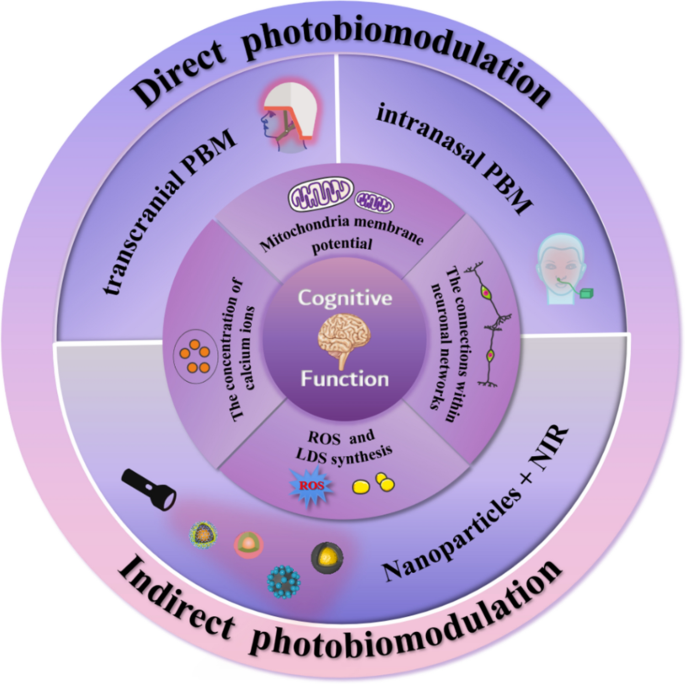Some Known Questions About Photobiomodulation.
Wiki Article
Photobiomodulation Things To Know Before You Get This
Table of ContentsNot known Details About Photobiomodulation 7 Simple Techniques For PhotobiomodulationA Biased View of PhotobiomodulationEverything about Photobiomodulation
Laser therapy is a clinical therapy that uses focused light to stimulate a process called. Throughout PBM, photons enter the cells and communicate with the cytochrome c facility within mitochondria. This communication triggers a biological waterfall of occasions that brings about a rise in cellular metabolic rate, which can as well as speed up the healing procedure.There is agreement that the application of a restorative dose of light to impaired or useless tissue results in a cellular action mediated by mitochondrial mechanisms. Photobiomodulation. Researches have actually shown that these changes can impact pain and inflammation, along with, cells repair
Modifications in ATP, responsive oxygen species and nitric oxide adhere to light absorption by Cc, O. These impacts are redox state and dosage reliant. In hypoxic or otherwise stressed out cells it has actually been revealed sometimes that adhering to, nitric oxide is launched, ATP is increased and oxidative stress is reduced [27-31]

8 Easy Facts About Photobiomodulation Described
PBM gadgets have been removed for advertising by FDA via the Premarket Notification/510( k) procedure as adjunctive gadgets for the short-lived alleviation of pain. These clearances were based on the presentation of medical information to support such claims (Photobiomodulation). In this therapy, a light source is positioned near or in contact with the skin, enabling the light energy (photons) to permeate cells where it engages with chromophores found in cells leading to photophysical and photochemical modifications that lead to alterations at the molecular, mobile and tissue levels of the bodySurprisingly, recent research study indicates that light can improve performance in typical tissues and cells. The prospective applications of PBMT are countless and are being discovered experimentally at the basic scientific research, pre-clinical and scientific level. The current professional uses are for the alleviation of pain and swelling and the therapy of sporting activities injuries.

The therapy criteria and number of sessions needed home for PBMT are reliant upon location and cause. PBMT typically requires more than one treatment for optimum pain alleviation.
Photobiomodulation Things To Know Before You Buy
Therapy parameters for PBMT were initially established making use of cells in vitro and in little animal versions. These treatment criteria normally had a low irradiance and fluence and functioned well for cutaneous applications. When medical professionals began to make use of PBMT to treat structures that were situated much deeper in the body, they utilized these specifications with adverse outcomes.
We currently comprehend that these unfavorable studies were due to incorrect device and therapy parameters for transcutaneous treatment of much deeper structures. Current developments in laser therapy devices and more research study into the proper dosages have actually dramatically enhanced the results of PBMT. For treating deep tissues, the wavelength of light made use of determines the deepness of infiltration into a cells.
It is important that a clinician utilizes the suitable wavelength of light and specifications to deal with a condition. One wavelength and one collection of therapy parameters will not work for all problems. Unfavorable side effects have not been reported from using PBMT (Photobiomodulation). Updated June 27, 2016Juanita j
more info here Light treatment is a non-invasive therapy that works by raising the ability of the cell to develop energy (ATP) to recover the area being treated. Consequently, it can reduce swelling, swelling, and pain in the area. Research study around is expanding, with more thorough study papers linked below for those that would love to find out more.
Getting The Photobiomodulation To Work
In the very first experiment, Dr. Endre Mester, used shaved rats and observing exactly how the laser impacted their ability to expand hair contrasted to the team that was not getting LLLT. He found that the group of mice obtaining LLLT had the ability to expand their hair back much more swiftly than the team of computer mice that didn't receive LLLT (Hoon C, et alia; 2012).This treatment is labelled this means to differentiate the difference in between the lasers some occupations make use of to cut (eg. Low-level light therapy is painless, non-invasive treatment.
LLLT has a biphasic feedback, indicating that reduced doses are typically seen to be extra valuable than greater dosages. That being stated, doses greater or less than the optimum dosage doesn't affect (Hoon C, et alia; 2012). For this reason, it can be tough to have research studies on LLLT with a lot of parameters.
Some companies browse this site integrated the 2 (LED and laser) to give a much more well-shaped therapy considering that lasers can permeate much deeper than LED and infrared light (Norman Doidge, The Brain's Means of Recovery, 2015). Throughout therapy, the location that is being treated is revealed to LED light from a Biography, Flex Laser, which is at 660 nm wavelength, complied with by infrared light at 830-840 nm wavelength.
Report this wiki page